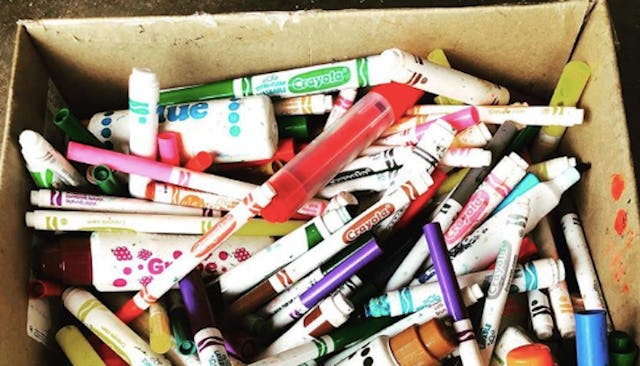Here's What Your Kid's School Needs To Do With Their Dried Out Markers

If you have a bunch of dried up Crayola markers, here’s how to dispose of them in an earth-friendly way
If you have piles of spent markers lurking in every corner of your home, just imagine how many there are at your child’s school. Kids not only use the heck out of markers, they’re also famous for leaving the caps off — which results in tons of “dead” markers every year that just go in a landfill. Thanks to Crayola, not anymore.
A mom’s super viral Facebook post highlights a service offered by Crayola that every single U.S. school needs to take advantage of. It’s called ColorCycle, and it’s as effortless as it is genius.
Maui mom Hali McCloud shared the happy news that thanks to the company’s ColorCycle program, a full 15 pounds of dead markers collected at her son’s preschool won’t end up in a landfill or the ocean. “Did you know that Crayola has a program called ColorCycle?” she writes. “If you collect the dead markers, they’ll send you a free shipping label and you can ship them back to Crayola to be recycled! My kids found out about this and were so excited to set up boxes at their schools.”
After collecting so many markers in only three months at just one school, McCloud marveled at the possibilities. “Imagine what we could divert from landfills during the whole school year at every school!”
As a mom with only two kids but approximately 4 million markers in my home, I’m fully with her. This can help our planet a whole lot, and it takes practically nothing on our part.
According to their website, Crayola is willing to pay the shipping when you return spent markers to them for recycling — with one caveat. “The only problem is, that right now they don’t pay for free shipping in Hawaii or Alaska, so I’m paying the shipping out of my own pocket but it’s totally worth it to not ever find these markers on our beaches!” McCloud writes.
While it stinks she has to pay shipping, that shouldn’t be an obstacle either if a bunch of parents can all kick in a buck or two.
Crayola makes the process extremely easy.
Image via Crayola
The first step is to tell your child’s school or the PTA about the program, and it’s hard to imagine a school or PTA that wouldn’t be down with something that costs them nothing and can help the planet. Then, you set up a collection station and let the used markers pile up. Pack them in a plain cardboard box and have FedEx Ground pick them up with Crayola footing the bill for shipping as long as you live in the continental U.S.
McCloud tells Scary Mommy that thousands of people commented on her post that they had no idea about the program. “The thought that my simple little post maybe got hundreds of people to set this up at their schools is amazing,” she says. McCloud tells us she wishes Crayola would contact her in the wake of her viral message so she could beg them to do free shipping for Alaska and Hawaii residents. “We have a lot of schools in Hawaii and on Maui, there’s virtually no recycling of any kind. Everything goes in a landfill so getting all these markers off the island feels great,” she tells us.
In the meantime, McCloud is working on a similar recycle program with Elmer’s glue. She also shared other ways she’s teaching her kids to be good to the earth including bento boxes for lunches instead of wasting tons of Ziplock bags every week, using steel drinking straws, and never buying plastic utensils. She even has a fun kid project that’s totally environmentally-friendly. “We take old, broken crayons and melt them into candy molds in the oven to make larger, rainbow crayons.”
RELATED: How To Get Crayon Off Walls And A Bunch Of Other Stuff — Because, Kids
Recycling dried markers is a total win-win. We can help the planet by doing almost nothing and teach our kids the importance of recycling by getting them to participate in something fun and on their level.
Now if only getting them to recap their markers were so simple.
This article was originally published on